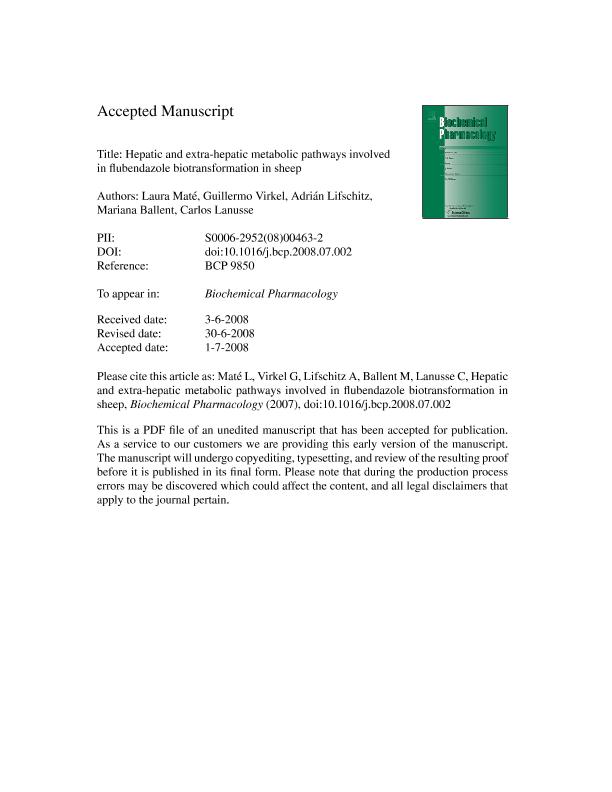Mostrar el registro sencillo del ítem
dc.contributor.author
Maté, María Laura

dc.contributor.author
Virkel, Guillermo Leon

dc.contributor.author
Lifschitz, Adrian Luis

dc.contributor.author
Ballent, Mariana

dc.contributor.author
Lanusse, Carlos Edmundo

dc.date.available
2020-01-28T19:30:58Z
dc.date.issued
2008-09
dc.identifier.citation
Maté, María Laura; Virkel, Guillermo Leon; Lifschitz, Adrian Luis; Ballent, Mariana; Lanusse, Carlos Edmundo; Hepatic and extra-hepatic metabolic pathways involved in flubendazole biotransformation in sheep
; Pergamon-Elsevier Science Ltd; Biochemical Pharmacology; 76; 6; 9-2008; 773-783
dc.identifier.issn
0006-2952
dc.identifier.uri
http://hdl.handle.net/11336/96016
dc.description.abstract
Flubendazole (FLBZ) is a broad-spectrum benzimidazole anthelmintic compound used in pigs, poultry and humans. Its potential for parasite control in ruminant species is under investigation. The objective of the work described here was to identify the main enzymatic pathways involved in the hepatic and extra-hepatic biotransformation of FLBZ in sheep. Microsomal and cytosolic fractions obtained from sheep liver and duodenal mucosa metabolised FLBZ into a reduced FLBZ metabolite (red-FLBZ). The keto-reduction of FLBZ led to the prevalent (∼98%) stereospecific formation of one enantiomeric form of red-FLBZ. The amounts of red-FLBZ formed in liver subcellular fractions were 3-4-fold higher (P < 0.05) compared to those observed in duodenal subcellular fractions. This observation correlates with the higher (P < 0.05) carbonyl reductase (CBR) activities measured in the liver compared to the duodenal mucosa. No metabolic conversion was observed following FLBZ or red-FLBZ incubation with sheep ruminal fluid. Sheep liver microsomes failed to convert red-FLBZ into FLBZ. However, this metabolic reaction occurred in liver microsomes prepared from phenobarbital-induced rats, which may indicate a cytochrome P450-mediated oxidation of red-FLBZ. A NADPH-dependent CBR is proposed as the main enzymatic system involved in the keto-reduction of FLBZ in sheep. CBR substrates such as menadione and mebendazole (a non-fluoride analogue of FLBZ), inhibited this liver microsomal enzymatic reaction, which may confirm the involvement of a CBR enzyme in FLBZ metabolism in sheep. This research is a further contribution to the understanding of the metabolic fate of a promissory alternative compound for antiparasitic control in ruminant species.
dc.format
application/pdf
dc.language.iso
eng
dc.publisher
Pergamon-Elsevier Science Ltd

dc.rights
info:eu-repo/semantics/openAccess
dc.rights.uri
https://creativecommons.org/licenses/by-nc-nd/2.5/ar/
dc.subject
ANTHELMINTICS
dc.subject
BIOTRANSFORMATION
dc.subject
CARBONYL REDUCTASE
dc.subject
FLUBENDAZOLE
dc.subject
MICROSOMES
dc.subject
SHEEP
dc.subject.classification
Ciencias Veterinarias

dc.subject.classification
Ciencias Veterinarias

dc.subject.classification
CIENCIAS AGRÍCOLAS

dc.title
Hepatic and extra-hepatic metabolic pathways involved in flubendazole biotransformation in sheep
dc.type
info:eu-repo/semantics/article
dc.type
info:ar-repo/semantics/artículo
dc.type
info:eu-repo/semantics/publishedVersion
dc.date.updated
2019-11-08T15:12:37Z
dc.journal.volume
76
dc.journal.number
6
dc.journal.pagination
773-783
dc.journal.pais
Estados Unidos

dc.description.fil
Fil: Maté, María Laura. Consejo Nacional de Investigaciones Científicas y Técnicas; Argentina. Universidad Nacional del Centro de la Provincia de Buenos Aires. Facultad de Ciencias Veterinarias. Departamento de Fisiopatología. Laboratorio de Farmacología; Argentina
dc.description.fil
Fil: Virkel, Guillermo Leon. Universidad Nacional del Centro de la Provincia de Buenos Aires. Facultad de Ciencias Veterinarias. Departamento de Fisiopatología. Laboratorio de Farmacología; Argentina. Consejo Nacional de Investigaciones Científicas y Técnicas; Argentina
dc.description.fil
Fil: Lifschitz, Adrian Luis. Consejo Nacional de Investigaciones Científicas y Técnicas; Argentina. Universidad Nacional del Centro de la Provincia de Buenos Aires. Facultad de Ciencias Veterinarias. Departamento de Fisiopatología. Laboratorio de Farmacología; Argentina
dc.description.fil
Fil: Ballent, Mariana. Universidad Nacional del Centro de la Provincia de Buenos Aires. Facultad de Ciencias Veterinarias. Departamento de Fisiopatología. Laboratorio de Farmacología; Argentina. Consejo Nacional de Investigaciones Científicas y Técnicas; Argentina
dc.description.fil
Fil: Lanusse, Carlos Edmundo. Universidad Nacional del Centro de la Provincia de Buenos Aires. Facultad de Ciencias Veterinarias. Departamento de Fisiopatología. Laboratorio de Farmacología; Argentina. Consejo Nacional de Investigaciones Científicas y Técnicas; Argentina
dc.journal.title
Biochemical Pharmacology

dc.relation.alternativeid
info:eu-repo/semantics/altIdentifier/doi/http://dx.doi.org/10.1016/j.bcp.2008.07.002
dc.relation.alternativeid
info:eu-repo/semantics/altIdentifier/url/https://www.sciencedirect.com/science/article/pii/S0006295208004632
Archivos asociados
